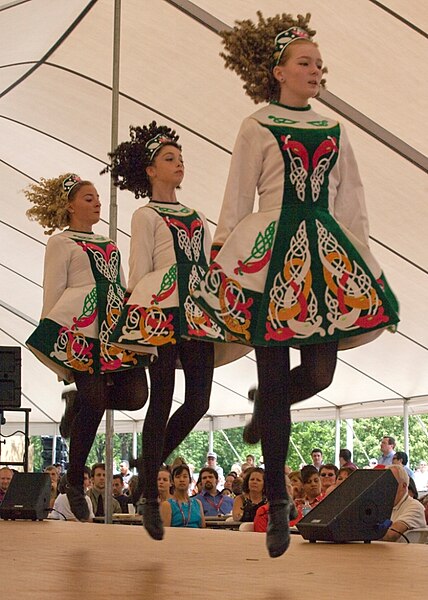Irish stepdance is a style of performance dance with its roots in traditional Irish dance. It is generally characterized by a stiff upper body and fast and precise movements of the feet. It can be performed solo or in groups. Aside from public dance performances, there are also stepdance competitions all over the world. These competitions are often called Feiseanna. In Irish dance culture, a Feis is a traditional Gaelic arts and culture festival. Costumes are considered important for stage presence in competition and performance Irish stepdance. In many cases, costumes are sold at high prices and can even be custom made. Each costume is different, with varying colors and patterns, designed to attract the judge's eye in competitions and the audience's eye in performance. General appearance beside the costume is also equally important. Female dancers would typically curl their hair before each competition or wear curled wigs, while male dancers would neatly style their hair to a shape to their liking. Poodle Socks are worn by female dancers while males wear plain black socks. Poodle socks are white socks that stretch to typically 1-4 inches above the ankle, depending on the dancers preference. They also have distinctive ribbing, and can be embroidered with gems.

Irish dancers performing at a show
Irish stepdancers performing in school costumes and hard shoes
A boy's costume. It may vary from a simple shirt and tie to waistjackets.
Irish step dancers in a St. Patrick's Day Parade in Fort Collins, Colorado
Irish dance refers to a group of traditional dance forms that originate in Ireland, encompassing dancing both solo and in groups, and dancing for social, competitive, and performance purposes. Irish dance in its current form developed from various influences such as earlier native Irish dance, English country dancing and later possibly French quadrilles, as it became popular in Britain and Ireland during the 19th century. Dance was taught by "travelling dance masters" across Ireland in the 17th and 18th centuries, and separate dance forms developed according to regional practice and differing purposes. Irish dance became a significant part of Irish culture, particularly for Irish nationalist movements. From the early 20th century, a number of organisations promoted and codified the various forms of dance, creating competitive structures and standardised styles. Irish dancers who compete for competitive reasons dance in a dance style that is more modern than traditional Irish dance. It is mainly done solo, but there is some team dancing in groups of 2, 3, 4, 6, 8, 10, 16 and even numbers onwards.

Most modern Irish dancers wear elaborate competition dresses, large wigs, and makeup for performance and competition purposes.
Irish Jig, from National Dances (N225, Type 2) issued by Kinney Bros 1889
Irish step dancers from Connemara Irish dancers in Wilkes-Barre, PA, dance at the Hetzel Union Building (HUB), Penn State University.
An untraditional dance style







